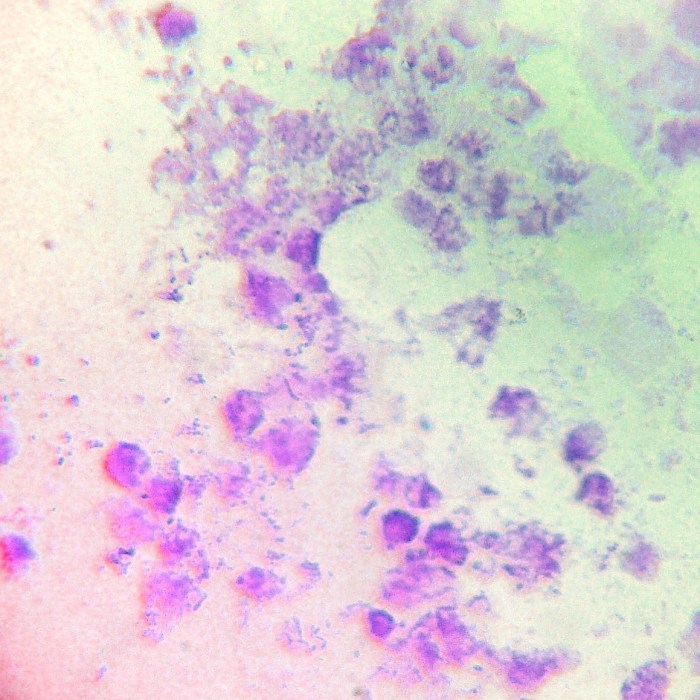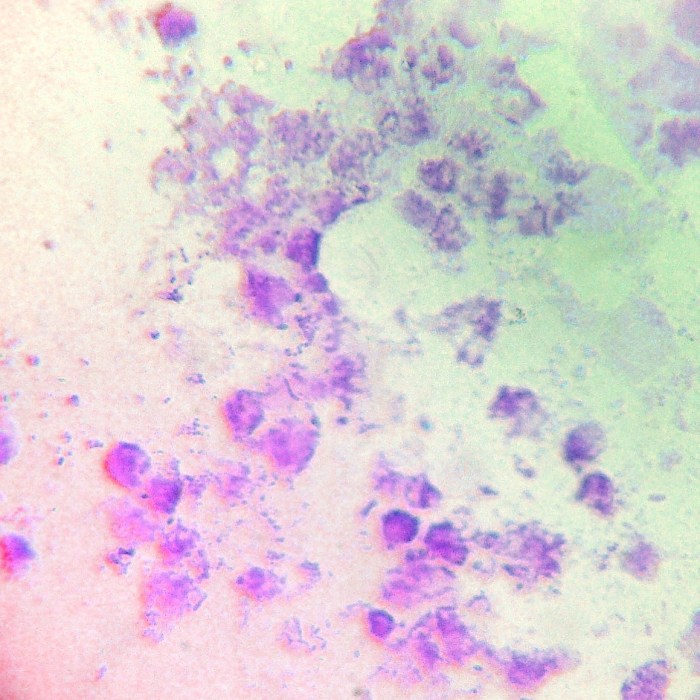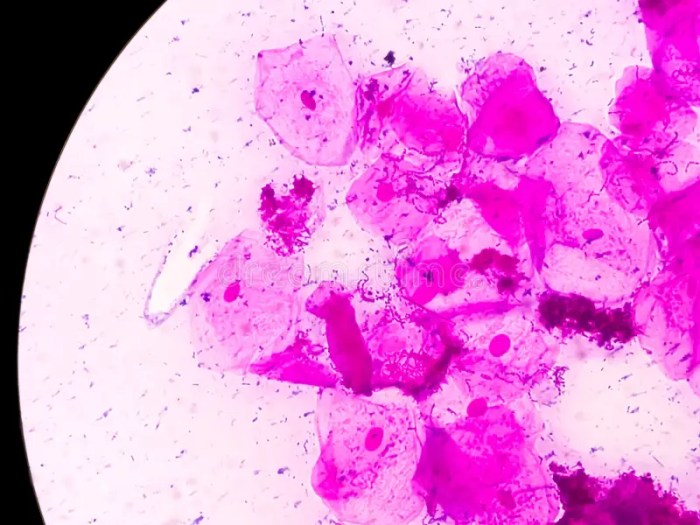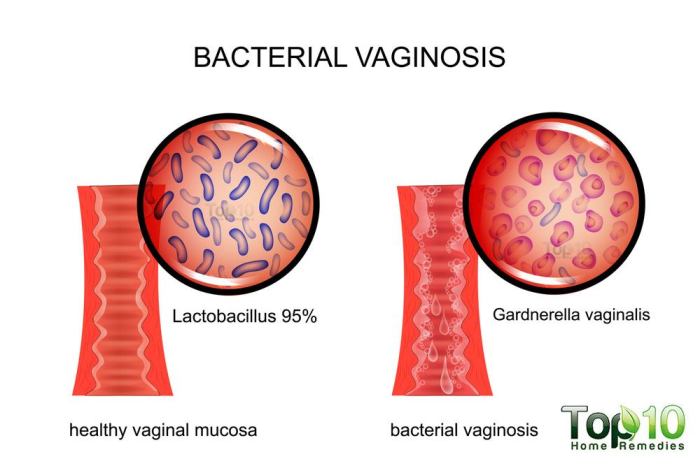Treat trichomoniasis at home: A comprehensive guide delves into the potential home remedies for this common STI, exploring their benefits, risks, and scientific backing. This guide also covers the importance of seeking professional medical advice, common misconceptions, and safe self-care practices. Learn how to navigate the complexities of treating trichomoniasis while prioritizing your health and well-being.
Trichomoniasis, a sexually transmitted infection (STI), can affect both men and women. While medical treatment is crucial, some individuals explore home remedies. This article examines potential options, but emphasizes the vital role of professional medical diagnosis and treatment. Understanding the symptoms, transmission, and potential risks of relying solely on home remedies is key.
Introduction to Trichomoniasis
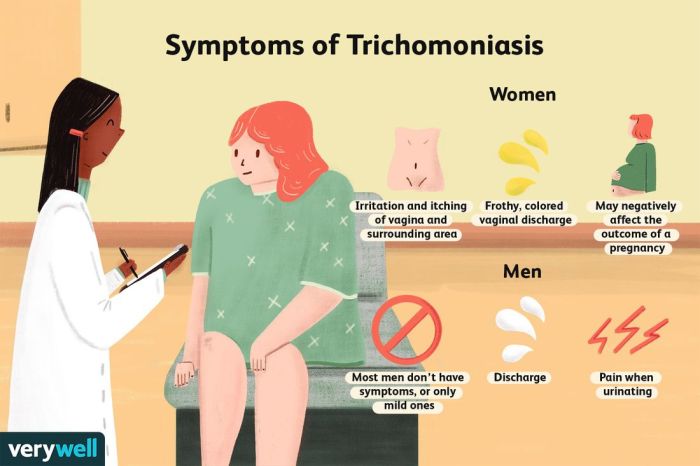
Trichomoniasis is a common sexually transmitted infection (STI) caused by a parasite calledTrichomonas vaginalis*. It’s a prevalent infection, often with minimal or no noticeable symptoms, which can lead to potential complications if left untreated. Understanding the symptoms, transmission, and importance of professional diagnosis is crucial for effective management.Trichomoniasis, often referred to as “trich,” affects both men and women.
While it can sometimes present without any noticeable symptoms, recognizing the common indicators is essential for prompt treatment and preventing the spread of the infection.
Defining Trichomoniasis
Trichomoniasis is a sexually transmitted infection (STI) caused by the microscopic parasiteTrichomonas vaginalis*. This parasite primarily infects the genital tract, affecting both men and women. It’s important to note that trichomoniasis is not a virus or bacteria, but a parasitic infection.
Common Symptoms in Men and Women
Trichomoniasis symptoms can vary significantly, and sometimes they are absent altogether. In both men and women, symptoms often appear a few weeks after exposure.
Symptoms in Men
Men frequently experience mild or no symptoms. When present, symptoms typically include: urethritis (inflammation of the urethra), characterized by discharge from the penis, and/or pain or burning during urination. These symptoms can be subtle and easily overlooked, highlighting the importance of regular STI screenings.
Symptoms in Women
Women with trichomoniasis may experience a range of symptoms, including:
- Vaginal discharge that is often frothy, yellow-green, and foul-smelling.
- Vaginal itching and irritation.
- Pain during urination or sexual intercourse.
These symptoms can be particularly bothersome and disrupt daily life.
Transmission Methods
Trichomoniasis is primarily transmitted through sexual contact, including vaginal, anal, and oral sex. The parasite can survive outside the body for short periods, but sexual contact remains the primary mode of transmission. This underscores the significance of safe sexual practices.
Treating trichomoniasis at home can be tricky, but focusing on a healthy lifestyle can definitely help. A balanced diet is key, and exploring options like a high protein vanilla matcha latte, as recommended by a dietitian like the one at high protein vanilla matcha latte dietitian , might contribute to overall well-being. Of course, remember that self-treating should always be approached with caution and ideally be discussed with a healthcare professional before making any significant dietary changes, especially when dealing with potential health issues like trichomoniasis.
Comparison of Symptoms in Men and Women
| Characteristic | Men | Women | Both |
|---|---|---|---|
| Discharge | Possible, often mild or absent | Often frothy, yellow-green, foul-smelling | Possible |
| Pain/Burning | Possible during urination | Possible during urination or intercourse | Possible |
| Itching/Irritation | Rare | Common | Possible |
| Other Symptoms | Urethritis | Vaginal itching/irritation | Possible absence of noticeable symptoms |
Importance of Professional Medical Advice
A healthcare provider is crucial for accurate diagnosis and appropriate treatment of trichomoniasis. Self-treating can delay proper care and potentially lead to complications. Early detection and treatment are essential to prevent the spread of the infection to partners and avoid potential long-term health issues. The healthcare provider can perform necessary tests and recommend the most suitable course of action, ensuring optimal health outcomes.
Home Remedies for Trichomoniasis
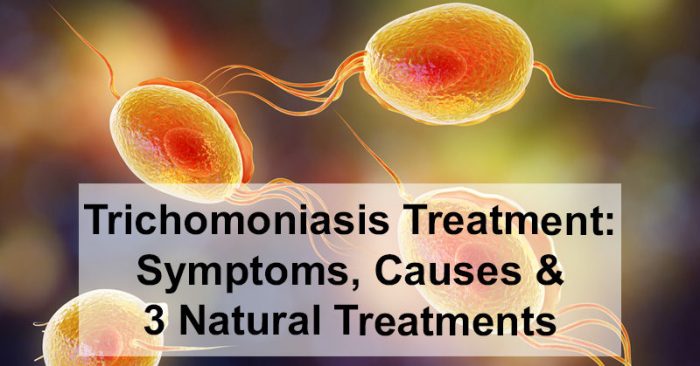
Exploring potential home remedies for trichomoniasis can be tempting, but it’s crucial to understand that these remedies are not a substitute for professional medical care. Trichomoniasis is a sexually transmitted infection (STI) requiring proper diagnosis and treatment by a healthcare provider. While some natural approaches might offer symptomatic relief, they are unlikely to cure the infection and could potentially mask the underlying issue, leading to complications.Trichomoniasis, if left untreated, can cause serious health problems, particularly in women.
It can lead to pelvic inflammatory disease (PID), ectopic pregnancy, and increased risk of HIV transmission. It’s vital to seek professional medical advice to confirm the diagnosis, receive appropriate medication, and understand the necessary steps to prevent the infection’s spread.
Potential Home Remedies
Several home remedies are often associated with treating trichomoniasis, but it’s essential to recognize that their efficacy is not supported by robust scientific evidence. These remedies should not be considered a replacement for medical treatment.
Potential Benefits, Risks, and Scientific Evidence
| Home Remedy | Potential Benefits | Potential Risks | Scientific Evidence |
|---|---|---|---|
| Probiotics | Some studies suggest probiotics may support vaginal health and potentially have an impact on the microbiome, but their role in treating trichomoniasis is not well-established. Some users report that probiotics can improve vaginal symptoms. | Probiotics, while generally safe, can cause digestive upset in some individuals. There’s a possibility of allergic reactions in those with sensitivities. Also, not all probiotic strains have proven effective against trichomoniasis. | Limited and inconclusive scientific evidence regarding trichomoniasis treatment. |
| Cranberry Juice | Cranberry juice is often touted for its purported urinary tract health benefits, potentially affecting bacteria, but its effectiveness against trichomoniasis is questionable. | High doses of cranberry juice can cause digestive issues like diarrhea and stomach cramps. It can also interact with certain medications. Some individuals may experience kidney problems if consumed in high quantities. | No significant scientific evidence to support its use in treating trichomoniasis. |
| Garlic | Garlic has some antimicrobial properties, but its effectiveness in treating trichomoniasis is not definitively proven. Some individuals report that consuming garlic may improve vaginal symptoms. | Garlic can cause nausea, heartburn, and bad breath. It can also interact with certain medications. Not all forms of garlic have been studied for trichomoniasis treatment. | Limited and inconclusive scientific evidence. |
| Apple Cider Vinegar | Apple cider vinegar is sometimes used topically for its potential antimicrobial properties, but there’s no strong scientific evidence supporting its effectiveness against trichomoniasis. Some users report relief from vaginal discomfort. | Applying apple cider vinegar topically can cause irritation and burning. It can also damage delicate vaginal tissues if not used correctly. | No substantial scientific evidence to support its use in treating trichomoniasis. |
Limitations and Dangers of Relying Solely on Home Remedies
Relying solely on home remedies for trichomoniasis can be dangerous. These remedies may not address the infection effectively, potentially allowing the infection to persist and cause further complications. Untreated trichomoniasis can lead to serious health problems. It is essential to consult a healthcare professional for diagnosis and treatment to ensure appropriate management of the infection and prevent potential complications.
Important Considerations for Home Treatments
While exploring home remedies for trichomoniasis, it’s crucial to understand that they are not a substitute for professional medical care. Trichomoniasis, if left untreated, can lead to significant health complications. Self-treating without a proper diagnosis can mask the infection, delaying effective treatment and potentially worsening the condition.Home remedies, while sometimes offering potential symptom relief, do not address the underlying cause of the infection.
A proper diagnosis and treatment plan from a healthcare professional are essential for eliminating the parasite and preventing further complications.
Critical Factors to Consider
Effective home remedies for trichomoniasis must be carefully evaluated within the context of a complete medical assessment. The efficacy of any home remedy for treating trichomoniasis is not universally supported by scientific evidence. Factors such as the severity of the infection, individual health conditions, and potential drug interactions should be thoroughly considered. Self-treating without a proper medical diagnosis and treatment plan can be detrimental to your overall health.
Essential Precautions for Using Home Remedies
Implementing home remedies for trichomoniasis necessitates careful consideration and adherence to safety protocols. The use of home remedies for trichomoniasis should be approached with extreme caution, as it is not a substitute for medical intervention.
- Consult a healthcare professional before trying any home remedy. This crucial step ensures that the chosen remedy is safe and compatible with your overall health status and any existing medical conditions. Improper use can exacerbate existing health issues or introduce new complications.
- Avoid using home remedies if pregnant or breastfeeding. Certain home remedies may pose risks to the developing fetus or infant, and their safety during pregnancy or breastfeeding has not been adequately established. Always prioritize the health of the mother and child by consulting a healthcare professional.
- Do not combine home remedies with other medications without professional guidance. Interactions between home remedies and prescribed medications can occur, potentially leading to adverse effects. A healthcare professional can assess potential drug interactions and advise on safe combinations.
Significance of Professional Medical Care
Delaying professional medical care for trichomoniasis can lead to serious complications. Early diagnosis and treatment are critical to prevent the spread of the infection to sexual partners and minimize the risk of long-term health issues.
- Untreated trichomoniasis can lead to pelvic inflammatory disease (PID) in women. PID is a serious infection that can damage reproductive organs and increase the risk of infertility.
- Trichomoniasis can increase the risk of HIV transmission. The infection can create sores or inflammation that make it easier for HIV to enter the body. This highlights the importance of prompt diagnosis and treatment to prevent further complications.
- Early intervention significantly reduces the risk of complications. Prompt treatment with prescribed medications can effectively eliminate the infection and prevent long-term health problems.
Potential Interactions Between Home Remedies and Existing Medications
The combination of home remedies with existing medications can result in unexpected and potentially harmful interactions. It is essential to consult a healthcare professional to determine the safety and appropriateness of combining home remedies with any prescribed medications.
- Some home remedies can interfere with the effectiveness of prescribed medications. For example, certain herbal remedies can alter the way the body processes medications, potentially reducing their effectiveness or increasing their side effects. It’s crucial to avoid such interactions.
- Interactions can also lead to unwanted side effects. The combined effects of home remedies and medications may produce side effects that were not anticipated or are more severe than expected. A healthcare professional can identify potential interactions and advise on appropriate management strategies.
Situations Requiring Immediate Medical Attention
Certain situations necessitate immediate medical attention for trichomoniasis, regardless of whether home remedies are being considered. Seeking prompt medical care is crucial for these situations to ensure the best possible outcomes.
- Severe pain or discomfort. Persistent or intense pain in the genital area, accompanied by fever, requires immediate medical attention. These symptoms may indicate a more severe infection or complications requiring immediate intervention.
- Difficulty urinating or unusual discharge. If you experience pain or difficulty urinating, or notice a change in the color, odor, or consistency of your discharge, seek immediate medical attention. These symptoms could indicate a more severe infection requiring prompt treatment.
- Presence of sores or ulcers. Any unusual sores or ulcers in the genital area should be evaluated immediately by a healthcare professional. These symptoms could signal a secondary infection or a more complex medical issue.
Misconceptions and Myths about Home Trichomoniasis Treatment: Treat Trichomoniasis At Home
Home remedies for trichomoniasis, while tempting, often fall short of providing effective treatment. Many popular beliefs circulate online and among individuals, leading to delays in seeking professional medical care. These misconceptions can have serious health consequences. Understanding these myths is crucial for making informed decisions about your health.
Common Misconceptions about Home Remedies
Many individuals believe home remedies can cure trichomoniasis without medical intervention. This often stems from anecdotal evidence or unverified claims online. It’s essential to recognize that these remedies are not backed by scientific evidence and may even be harmful. Trichomoniasis is a sexually transmitted infection (STI) requiring specific treatment, and self-treating with unproven methods can lead to prolonged infection, complications, and the potential spread to others.
Misleading Information and Claims
Some websites and individuals promote home remedies for trichomoniasis that lack scientific backing. These claims often include using herbal concoctions, dietary changes, or other methods with no proven efficacy. It’s important to critically evaluate information found online and consult with healthcare professionals for accurate advice. Untested remedies may delay appropriate treatment and worsen the infection.
Dangers of Self-Treating Trichomoniasis
Self-treating trichomoniasis can have severe consequences. Untreated infections can lead to more serious health problems, including pelvic inflammatory disease (PID) in women, and potential complications during pregnancy. Delaying treatment also increases the risk of spreading the infection to sexual partners. Accurate diagnosis and prescribed treatment are crucial for successful resolution of the infection and prevention of further complications.
Proper medical care is vital.
Importance of Accurate Diagnosis, Treat trichomoniasis at home
A proper diagnosis by a healthcare professional is essential for effective treatment. Trichomoniasis symptoms can mimic those of other conditions, and a self-diagnosis may lead to incorrect treatment. Only a medical professional can accurately identify trichomoniasis and recommend the appropriate course of action. A healthcare provider can perform necessary tests to confirm the diagnosis and rule out other potential conditions.
Comparison of Facts and Myths
| Myth | Explanation | Fact | Explanation |
|---|---|---|---|
| Herbal teas can cure trichomoniasis. | Some claim specific herbal teas have curative properties. | Herbal remedies are not proven effective against trichomoniasis. | Scientific evidence does not support the use of herbal teas as a cure for trichomoniasis. |
| Dietary changes can eliminate trichomoniasis. | Some believe specific diets can eliminate the infection. | Dietary changes alone do not treat trichomoniasis. | Trichomoniasis is a bacterial infection requiring antibiotics for effective treatment. |
| Washing the genital area frequently can prevent trichomoniasis. | This practice is often recommended as a preventive measure. | Frequent genital washing does not prevent trichomoniasis. | Trichomoniasis transmission occurs through sexual contact. Hygiene practices are not sufficient for prevention. |
| Using vinegar douches can treat trichomoniasis. | Some believe vinegar douches can eliminate the infection. | Vinegar douches can cause irritation and are not effective for trichomoniasis. | Vinegar douches are not a medically recognized treatment and can cause harm. |
Potential Consequences of Ignoring Medical Advice
Ignoring medical advice regarding trichomoniasis can lead to serious consequences. Untreated infections can spread to other parts of the body, leading to complications such as PID in women, which can cause infertility or chronic pain. Moreover, untreated trichomoniasis can increase the risk of HIV transmission. Seeking professional medical help and adhering to the prescribed treatment plan is crucial for a complete recovery.
Safe Practices and Precautions for Self-Care
Taking care of your health at home, especially when dealing with potential trichomoniasis, involves a multifaceted approach. This includes not only addressing the symptoms but also implementing preventive measures to avoid reinfection and potential complications. Understanding the importance of hygiene, safe sexual practices, and proper self-care is crucial for a successful recovery.Careful attention to hygiene and personal protective measures is essential to prevent reinfection and promote healing.
Implementing these practices reduces the risk of complications and contributes to overall well-being.
Maintaining Proper Hygiene
Maintaining meticulous hygiene is paramount in preventing the spread of trichomoniasis and promoting healing. This involves a comprehensive approach to cleanliness, extending beyond just the affected area.
- Frequent Handwashing: Thorough handwashing with soap and water, especially after using the restroom and before preparing food, is critical in preventing the spread of trichomoniasis and other infections. This simple practice can significantly reduce the risk of reinfection.
- Cleanliness of Personal Items: Thoroughly clean all personal items like underwear, towels, and washcloths daily using hot water and detergent. Proper cleaning eliminates potential pathogens and helps prevent reinfection. Using separate towels and washcloths for personal use, and washing them frequently, is recommended.
- Careful Toilet Hygiene: After using the restroom, always wipe from front to back to prevent the spread of bacteria and potential reinfection. This practice minimizes the risk of contamination.
Avoiding Reinfection
Preventing reinfection is key to effective self-care for trichomoniasis. Understanding the transmission pathways and adopting preventive measures is crucial.
Trying to treat trichomoniasis at home? Knowing your family’s medical history, like recording family medical history , might be surprisingly helpful. While home remedies might offer some relief, it’s crucial to remember that proper medical diagnosis and treatment are essential. Consulting a doctor is always the best course of action for effectively managing trichomoniasis.
- Sexual Abstinence: For the duration of treatment and until both partners have been successfully treated, abstaining from sexual activity is essential to prevent reinfection. This is a critical measure to prevent spreading the infection and ensuring successful treatment for both individuals.
- Consistent Partner Treatment: If a sexual partner has trichomoniasis, both partners must be treated simultaneously. Failure to treat both partners can lead to reinfection and ongoing transmission. This practice ensures a complete resolution of the infection within the relationship.
- Using Condoms: Consistent and correct use of condoms during sexual activity can significantly reduce the risk of trichomoniasis transmission. Proper condom use is a key preventative measure to protect both partners.
Safe Sexual Practices
Safe sexual practices are crucial for preventing the transmission of trichomoniasis and other sexually transmitted infections (STIs). Open communication and mutual respect are essential for healthy sexual relationships.
- Open Communication: Open and honest communication with sexual partners about sexual health is vital. Discussing any concerns or symptoms is essential for both partners to protect their health and well-being.
- Mutual Respect: Respect for each other’s needs and boundaries is crucial in sexual relationships. This encompasses respecting each other’s physical and emotional boundaries, and making informed choices.
Proper Cleaning Procedures for Personal Items
Cleaning personal items like underwear, towels, and washcloths correctly is vital for preventing reinfection. The goal is to eliminate potential pathogens and maintain a hygienic environment.
- Laundry Instructions: Wash personal items like underwear, towels, and washcloths in hot water with detergent to eliminate pathogens. This process effectively sanitizes the items and reduces the risk of reinfection.
- Drying Instructions: Dry all personal items thoroughly to prevent the growth of bacteria or fungi. Drying them thoroughly is critical in eliminating any remaining pathogens.
When to Seek Professional Medical Attention
While home remedies can offer some relief from the discomfort of trichomoniasis, it’s crucial to understand when seeking professional medical attention is absolutely necessary. Ignoring certain symptoms or delaying treatment can lead to complications and hinder your overall recovery. Proper diagnosis and treatment by a healthcare professional are essential for managing this infection effectively.Trichomoniasis, if left untreated, can potentially lead to more serious health issues.
This underscores the importance of recognizing warning signs and promptly seeking medical care. A healthcare provider can provide the appropriate diagnosis and treatment plan, ensuring the infection is addressed effectively and preventing further complications.
Specific Situations Requiring Immediate Medical Intervention
Ignoring certain symptoms or delaying treatment for trichomoniasis can have significant consequences. Prompt medical intervention is vital in preventing potential complications. These situations warrant immediate consultation with a healthcare professional.
- Presence of severe pain or discomfort in the genital area, abdomen, or pelvis. This includes intense burning sensations during urination or intercourse, as well as persistent pelvic pain that is not alleviated by over-the-counter pain relievers.
- Development of fever or chills. A sudden rise in body temperature, often accompanied by chills, can be a sign of a more serious underlying infection or complication.
- Presence of unusual vaginal discharge with an unpleasant odor. A change in the color, consistency, or odor of vaginal discharge, beyond the typical variations experienced by individuals, warrants medical evaluation.
- Signs of urinary tract infection (UTI). Symptoms such as frequent urination, painful urination, or blood in the urine necessitate immediate consultation with a healthcare provider.
- Difficulty in urinating or experiencing urinary retention. Inability to urinate or experiencing prolonged or frequent urination with pain can be indicative of a blockage or infection requiring prompt medical attention.
- Experiencing bleeding between menstrual periods or after intercourse. Uncommon bleeding patterns, including bleeding between periods or after sexual activity, should prompt immediate evaluation by a healthcare professional.
Symptoms Warranting Urgent Consultation
Certain symptoms, though not necessarily life-threatening, require prompt evaluation by a healthcare professional to determine the underlying cause and initiate appropriate treatment. These symptoms warrant urgent medical attention.
- Persistent vaginal itching and irritation. Continuous or worsening itching and irritation in the genital area, beyond the initial discomfort associated with trichomoniasis, may indicate an underlying condition or a secondary infection.
- Unusual sores or lesions in the genital area. Any unusual sores, bumps, or lesions in the genital region, or any changes to existing ones, should be promptly evaluated by a healthcare professional.
- Painful or swollen testicles in males. Swelling or pain in the testicles in males can be a sign of a complication related to trichomoniasis or another infection. Prompt medical attention is essential to determine the cause and initiate treatment.
Critical Importance of Proper Diagnosis and Treatment
Proper diagnosis and treatment are essential for managing trichomoniasis effectively. Delaying or neglecting treatment can lead to significant complications, including the development of more serious infections or the spread of the infection to others. The healthcare professional’s role in providing accurate diagnosis and tailored treatment is crucial.
- Accurate diagnosis helps ensure the correct treatment is initiated. A misdiagnosis can lead to ineffective treatment and potentially exacerbate the condition.
- Treatment prevents the spread of the infection. Prompt treatment helps limit the risk of transmitting trichomoniasis to sexual partners.
- Proper treatment promotes healing and reduces the risk of complications. Following a healthcare professional’s treatment plan ensures that the infection is addressed effectively and that the body’s natural healing processes are supported.
Signs Indicating the Need for Immediate Medical Attention
Recognizing specific signs and symptoms can help determine when immediate medical attention is required. These indicators highlight situations requiring prompt medical consultation.
- Sudden onset of severe abdominal pain. This includes any acute pain in the lower abdomen that is intense and persistent, requiring immediate medical attention.
- High fever that persists for more than 24 hours. A high fever that does not subside within a day should be addressed promptly to prevent potential complications.
- Difficulty breathing or shortness of breath. These symptoms can indicate a more serious underlying condition and require immediate medical intervention.
- Presence of severe nausea or vomiting. Persistent nausea and vomiting can be a sign of an underlying infection or complication.
- Swelling or redness in the genital area that is increasing in size or severity. Any worsening swelling or redness in the genital area should be evaluated by a healthcare professional.
Following a Healthcare Professional’s Advice
Adherence to the healthcare professional’s advice is critical for successful treatment and recovery. Following the prescribed course of treatment is essential for eliminating the infection and preventing potential complications.
Treating trichomoniasis at home can be tricky, and it’s important to remember that self-treating can sometimes mask underlying issues. While some people might turn to alternative remedies, it’s crucial to consult a healthcare professional for accurate diagnosis and treatment. For instance, understanding the different uses, efficacy, and potential side effects of medications like Ozempic semaglutide is vital when considering any potential treatment options.
Knowing more about ozempic semaglutide uses efficacy side effects can help you navigate the complex world of healthcare choices, but always prioritize professional medical advice when it comes to treating trichomoniasis at home.
- Adherence to the prescribed medication regimen is crucial. Skipping doses or stopping treatment prematurely can hinder the effectiveness of the medication and lead to treatment failure.
- Regular follow-up appointments are important for monitoring progress and addressing any concerns. Maintaining open communication with your healthcare provider is essential for effective management of the infection.
- Informing sexual partners about the diagnosis and treatment is essential for preventing reinfection. Open communication and responsible sexual health practices are vital for everyone involved.
Additional Resources for Information and Support
Taking care of your health, especially when dealing with a condition like trichomoniasis, involves more than just home remedies. Reliable information and support from qualified professionals are crucial for a comprehensive approach. This section explores resources that can help you navigate the complexities of this infection and ensure your well-being.
Reliable Websites and Organizations
Accessing accurate and up-to-date information is essential for managing trichomoniasis effectively. Reputable sources offer detailed explanations of the condition, treatment options, and preventative measures. These sites often provide valuable insights beyond basic home remedies, empowering you with the knowledge to make informed decisions.
- The Centers for Disease Control and Prevention (CDC) is a cornerstone of public health information. Their website provides comprehensive details on trichomoniasis, including symptoms, diagnosis, treatment, and prevention strategies. Their data is backed by scientific research and government-backed expertise.
- The World Health Organization (WHO) offers global perspectives on various health issues, including sexually transmitted infections. Their website provides information about trichomoniasis’s global impact, treatment guidelines, and prevention efforts.
- Planned Parenthood offers accurate and accessible information on a wide range of reproductive health topics, including STIs like trichomoniasis. Their website provides clear explanations and resources tailored to diverse needs.
- Mayo Clinic’s website provides in-depth medical information on a broad spectrum of health concerns, including trichomoniasis. Their articles are often written by medical professionals, ensuring high standards of accuracy and credibility.
Finding a Qualified Healthcare Professional
Seeking guidance from a qualified healthcare provider is vital for an accurate diagnosis and appropriate treatment of trichomoniasis. They can offer personalized care and address any concerns you might have.
- Consult your primary care physician: Your primary care physician can evaluate your symptoms and, if necessary, refer you to a specialist. They can assess your overall health and provide initial guidance.
- Seek recommendations from trusted sources: Ask friends, family members, or other healthcare professionals for recommendations on qualified doctors specializing in infectious diseases or women’s health (for females). Consider online reviews from verified sources, but be cautious of unverified testimonials.
- Use online directories: Numerous online directories allow you to search for healthcare providers based on location, specialization, and patient reviews. Ensure the directory is reputable and provides verified information.
Importance of Seeking Support
Facing a health challenge like trichomoniasis can be emotionally taxing. Seeking support from trusted sources can significantly impact your mental and emotional well-being.
Support from friends, family, or support groups can provide emotional comfort and practical advice during this time. Remember, you are not alone in this journey.
Reliable Sources for Trichomoniasis Information
This table presents a concise overview of reliable sources for information on trichomoniasis, categorizing them for easy reference.
| Organization | Website | Specialization | Key Features |
|---|---|---|---|
| Centers for Disease Control and Prevention (CDC) | www.cdc.gov | Public Health | Comprehensive information on STIs, including trichomoniasis, backed by scientific evidence. |
| World Health Organization (WHO) | www.who.int | Global Health | Provides global perspectives on health issues, treatment guidelines, and prevention strategies. |
| Mayo Clinic | www.mayoclinic.org | Medical Expertise | In-depth medical information on a variety of health conditions, including trichomoniasis, authored by medical professionals. |
| Planned Parenthood | www.plannedparenthood.org | Reproductive Health | Accessible information on STIs and other reproductive health topics, tailored to diverse needs. |
Support Groups
Support groups provide a platform for individuals facing similar health challenges to connect, share experiences, and offer mutual support. These groups offer valuable emotional and practical resources, which can be extremely helpful in managing the stress and anxiety associated with trichomoniasis.
Joining a support group, whether online or in-person, can foster a sense of community and understanding. Sharing experiences and coping mechanisms with others who understand can be incredibly beneficial.
Final Thoughts
In conclusion, while some people consider home remedies for trichomoniasis, it’s essential to recognize the limitations and potential dangers. This comprehensive guide highlights the importance of seeking professional medical care for diagnosis and treatment. Remember, self-treating can be risky and may delay effective care. Prioritize your health by consulting a healthcare provider. Always consult a medical professional before attempting any home remedy.

